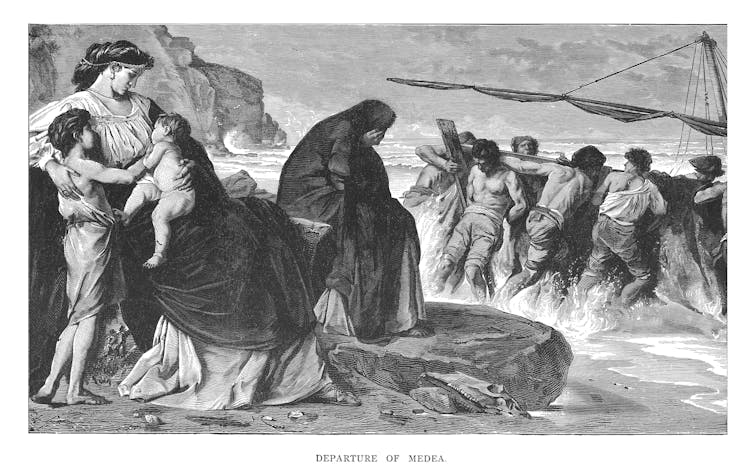What Greek fable tells us about fashionable witchcraft

[ad_1]
Residing on the North Shore in Boston within the fall brings the attractive turning of the leaves and pumpkin patches. It’s also a time for folks to head to close by Salem, Massachusetts, house of the seventeenth century notorious witch trials, and go to its in style museum.
Regardless of a troubled historical past, there are folks right now who contemplate themselves witches. Usually, fashionable witches share their lore, craft and tales on TikTok and different social media platforms.
As a scholar who works on fable and poetry from historic Greece – and as a local of New England – I’ve lengthy been fascinated by the cultural conversations about witches. Witch trials within the Americas and Europe had been partially about imposing energy constructions and persecuting the weak. From historic Greece by way of Puritan New England, witches functioned as straightforward targets for cultural anxieties about gender, energy and mortality.
Historic witches: gender and energy
Whereas fashionable witchcraft is inclusive of many alternative genders and identities, witches in historic fable and literature had been virtually completely girls. Their tales had been partially about navigating gender roles and energy in a patriarchal system.
Concern about girls’s energy was an important a part of historic nervousness about witchcraft. This worry, furthermore, relied on conventional expectations in regards to the talents innate to an individual’s gender. As early because the creation narrative in Hesiod’s “Theogony” – a poem hailing from a poetic custom between the eighth and fifth centuries B.C. – male gods like Cronus and Zeus had been depicted with bodily power, whereas feminine figures had been endowed with intelligence. Specifically, girls knew in regards to the mysteries of childbirth and how you can increase kids.
Within the fundamental framework of Greek fable, then, males had been sturdy and girls used intelligence and tips to deal with their violence. This gendered distinction in traits mixed with historic Greek views of our bodies and growing old. Whereas girls had been seen to maneuver by way of levels of life primarily based on biology – childhood, adolescence through menstruation, childbearing and outdated age – the growing old of males was linked to their relationship to girls, significantly in getting married and having kids.
Each Greek and Latin have a single phrase for man and husband – “aner” in Greek and “vir” in Latin. Socially and ritually, males had been primarily seen as adolescents till they grew to become husbands and fathers.
Feminine management over copy was symbolized as a form of skill to manage life and dying. In historic Greece, girls had been anticipated to bear all tasks throughout early baby rearing. Additionally they had been those to completely tackle particular roles in mourning the lifeless. Suspicion, nervousness and worry about mortality had been then placed on to girls basically.
Highly effective girls
This was true particularly for girls who didn’t match into typical gendered roles just like the virtuous bride, the great mom or the useful outdated maid.
Whereas historic Greek doesn’t have a phrase that instantly interprets as “witch,” it does have “pharmakis” (somebody who provides out medication or medication), “aoidos” (singer, enchantress) and “graus” or “graia” (outdated lady). Of those names, graus might be closest to later European stereotypes: the mysterious outdated lady who isn’t a part of a standard household construction.
Very similar to right now, foreignness invited suspicion within the historic world as effectively. A number of of the characters who could qualify as legendary witches had been girls from distant lands. Medea, well-known for killing her kids when her husband, Jason, proposes marrying another person in Euripides’ play, was a girl from the east, a foreigner who didn’t adhere to the expectations for a girl’s habits in Greece.
She began her narrative as a princess who used concoctions and spells to assist Jason. Her powers elevated male virility and life.

mikroman6/Second through Getty Photos
Medea allegedly discovered her magical craft from her aunt, Circe, who exhibits up in Homer’s “Odyssey.” She lived alone on an island, luring males to her cabin with seductive foods and drinks to show them into animals. Odysseus defeated her with an antidote supplied by the god Hermes. As soon as her magic failed, Circe believed she had no alternative however to undergo Odysseus.
Witches over time
Elsewhere within the “Odyssey” there are comparable themes: the Sirens who sing to Odysseus are enchantresses who attempt to take management of the hero. Earlier within the epic, the viewers witnesses Helen, whose departure with the Trojan prince Paris was the reason for the Trojan Conflict, add an Egyptian drug referred to as nepenthe to the wine she provides to her husband, Menelaos, and Odysseus’ son, Telemachus. This wine was so sturdy, it made folks neglect in regards to the ache of shedding even a liked one.
In every of those instances, girls who follow magic threaten to exert management over males with instruments that may also be a part of a pleasurable life: songs, intercourse and households. Different myths of monstrous girls reinforce how misogynistic stereotypes animate these beliefs. The historic determine Lamia, for instance, was a as soon as stunning lady who stole and killed infants as a result of her kids had died.
Empousa was a vampiric creature who consumed the intercourse and blood of younger males. Even Medusa, well-known because the snake-haired Gorgon who turned males to stone, was reported in some sources to have really been a girl so stunning that Perseus reduce her head off to point out it off to his buddies.
These examples are from fable. There have been many dwelling traditions of ladies’s therapeutic and track cultures which were misplaced over time. Many tutorial authors have traced the trendy practices of witchcraft to historic cults and the survival of pagan traditions exterior of mainstream Christianity. Current research of historic magical practices present how widespread and different they had been.
Whereas historic girls had been possible topic to suspicion and slander for witchcraft, there isn’t a proof that they confronted the form of widespread persecution of witches that swept Europe and the Americas a couple of centuries in the past. The later twentieth century, nevertheless, noticed renewed curiosity in witchcraft, typically in live performance with actions empowering girls.
Fashionable witches are crossing worldwide borders and studying from one another with out leaving their properties by creating communities on social media, like TikTok. If worry about girls’s energy led to paranoia previously, exploring and embracing witchcraft has turn out to be a part of reclaiming girls’s histories.
[ad_2]
Source_link




